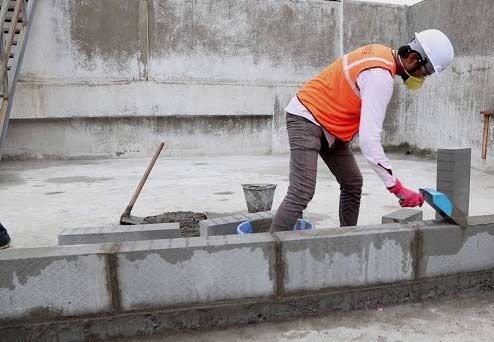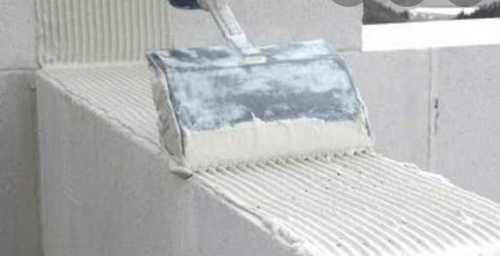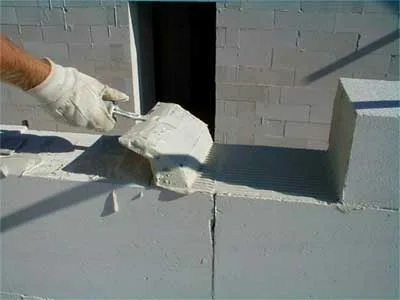AAC (Autoclaved Aerated Concrete) block jointing mortar is a specialised adhesive used for joining AAC blocks. It is a cement-based material with additives to enhance its performance. This mortar is designed to provide strong and durable bonds between AAC blocks, ensuring structural stability in construction. It typically comes in a pre-mixed form and requires the addition of water before application.
Advantages of AAC block jointing mortars
- Lightweight construction for easier handling and transport.
- Airtight joints provided by the mortar enhance overall energy efficiency.
- Quick-setting properties lead to faster construction, reducing project timelines.
- Precise mix design minimizes material wastage for cost-effectiveness and sustainability.
- Strong bond between AAC blocks due to the mortar’s formulation.
- Low shrinkage reduces the likelihood of cracks in joints over time.
- Controls pests and mold growth, promoting durability and hygiene.
- Good fire resistance enhances safety of the constructed building.
- Comes in a pre-mixed form eliminating the need for on-site mixing.
- Dries faster resulting in time savings during construction.
Different types of AAC block jointing mortars
1. Thin-bed Mortar:
Thin-bed mortar is characterized by its minimal thickness when applied, making it ideal for constructing walls with AAC blocks efficiently. It boasts high adhesive strength, ensuring a secure bond between the blocks. The thin application allows for quick setting and facilitates a speedy construction process. This mortar type is advantageous in projects where time is of the essence, and its excellent adhesion contributes to the structural stability of the wall.

2. Block Adhesive Mortar:
Block adhesive mortar is formulated to establish a robust connection with AAC blocks, ensuring a durable and long-lasting bond. Its key feature lies in its ability to provide a secure and stable attachment between the blocks, contributing significantly to the structural integrity of the building. This type of mortar is commonly used in various construction applications where a reliable and strong bond is essential.

3. Polymer-modified AAC Mortar:
Polymer-modified AAC mortar stands out for its enhanced properties, thanks to the inclusion of polymers. These polymers improve flexibility, adhesion, and water resistance. The mortar’s flexibility allows it to accommodate minor movements, making it particularly suitable for regions with varying weather conditions. Its resistance to water ensures the longevity of the bond, making it an excellent choice for outdoor applications.

4. Ready-mix AAC Mortar:
Ready-mix AAC mortar is characterized by its convenience and consistency. Being pre-mixed, it eliminates the need for on-site blending, ensuring accurate proportions for optimal performance. This mortar type is advantageous in large-scale construction projects where uniformity in the mortar mix is important. Its ready-to-use nature contributes to time efficiency and simplifies the construction process.

5. AAC Block Adhesive with Accelerator:
AAC block adhesive with accelerator is distinguished by its ability to expedite the curing process. The inclusion of accelerators ensures rapid setting, making it particularly useful in projects with tight timelines. This mortar type accelerates construction by allowing for quicker block assembly while maintaining a strong and reliable bond. Its time-saving feature is instrumental in projects where speed is a priority.

6. Cement-based AAC Mortar:
Cement-based AAC mortar, composed of cement, sand, and additives, offers versatility and reliability. Its key features include a traditional cement-based composition, making it suitable for various applications. This mortar type is commonly used in both residential and commercial construction projects where a proven and dependable cement-based solution is preferred. Its versatility makes it adaptable to different project requirements.

Prerequisites for selecting the right AAC block jointing mortars
- Check block type compatibility (AAC, concrete, clay).
- Evaluate project needs for load-bearing, stability, and fire resistance.
- Properly prepare surfaces for better mortar adhesion.
- Assess mortar’s adhesive strength to prevent cracks.
- Consider curing time for project timelines and joint setting.
- Evaluate weather resistance for environmental conditions.
- Ensure compliance with local building codes for safety.
- Choose flexible mortar for structure movement accommodation.
- Balance cost with performance for suitable and durable options.
Applications method for AAC block jointing mortars
1. Surface Preparation:
– Ensure the AAC blocks are clean and free from dust.
– Dampen the block surface slightly before applying the mortar.
2. Mixing:
– Follow the manufacturer’s instructions for mixing the jointing mortar.
– Typically, mix the mortar with clean water to achieve a smooth, lump-free consistency.
3. Application:
– Use a notched trowel to spread the mortar evenly on the block surface.
– Apply a thin layer of mortar on the vertical edges and horizontal bed joints of the AAC blocks.
4. Placement of AAC Blocks:
– Press the AAC blocks firmly into the mortar, ensuring proper alignment.
– Use a rubber mallet to gently tap the blocks into place.
5. Tooling Joints:
– Tool the joints with a jointing tool or a pointed trowel to achieve a smooth finish.
– Ensure uniform and consistent joint thickness.
6. Curing:
– Allow the mortar to cure as per the manufacturer’s recommendations.
– Maintain a moist environment to promote proper curing.
7. Clean Excess Mortar:
– Clean any excess mortar from the face of the AAC blocks while it is still fresh.
Always refer to the specific guidelines provided by the manufacturer of the AAC block jointing mortar for the best results.
Conclusion
AAC block jointing mortar plays an important role in ensuring the stability and durability of the structures built with Autoclaved Aerated Concrete blocks. Its application involves meticulous surface preparation, precise mixing, and careful placement of AAC blocks. By following the recommended procedures, including proper curing, one can achieve strong, durable bonds between the blocks. As the construction industry continues to embrace sustainable and innovative materials, AAC block jointing mortar stands out as a reliable solution for creating resilient and eco-friendly structures.

